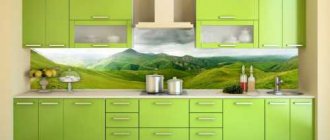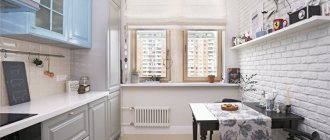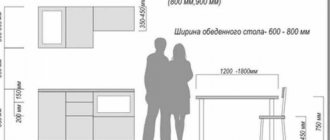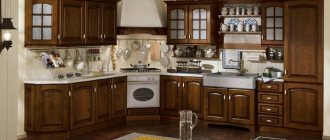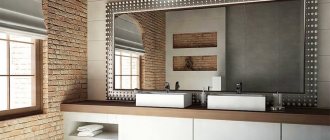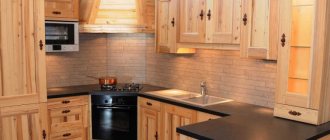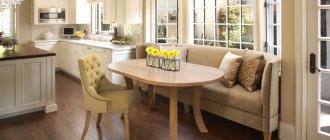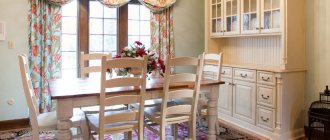Do you want to create a beautiful and original interior in your kitchen and at the same time for a reasonable price? In this case, pay attention to plastic aprons for finishing the work area. Modern plastic in terms of strength, performance characteristics and durability is a worthy competitor to glass and ceramic tiles when creating a kitchen apron. And the use of photo printing allows you to make the kitchen more comfortable and beautiful.
To enhance the color balance in the room, designers recommend using kitchen aprons that contrast with the furniture. By combining different shades with plot drawings, you can design and highlight your work area in a rather original way.
If bright colors do not match the overall interior, then you can install transparent plastic, making lighting behind the apron, which will add depth, visually expand the space and create a festive mood.
A plastic kitchen apron with photo printing is an excellent solution in terms of price-quality ratio and ease of installation. It’s worth figuring out where plastic is inferior to glass, ceramic tiles and other facing materials, and where it can be a worthy competitor.
Types of kitchen aprons made of plastic
Among the plastic panels produced for creating a kitchen apron, there are three main types:
- PVC panels are produced in widths of 100–500 mm, lengths of 2,600, 2,700 and 3,000 mm and thickness of 5–10 mm. During installation, seams are formed and if the installation is not carried out professionally, there may be gaps into which fat and water will subsequently get in, and this can create an environment for the development of microorganisms. To avoid problems, it is better to make a custom-made plastic apron with photo printing and entrust its installation to specialists.
- Sheet plastic. It makes it possible to obtain a smooth and seamless surface, for which a panel of the appropriate size is cut out of a single piece of canvas, which is then mounted on the wall.
- The most durable is another type of plastic – carbonate glass. This material is transparent and has refractory and metal-like characteristics. It is very difficult to break and practically does not form dents. And in addition to its functional purpose, the kitchen apron is also pleasing to the eye, it is worth ordering panels with photo printing.
How to properly install a plastic screen
Its installation is possible in two ways: with glue and with lathing. In the first case, the walls must be perfectly smooth, in the second, their condition is much less important. However, in the first case, the appearance of fungi or mold is excluded, and in the second, this possibility remains, since free space is maintained between the screen and the wall.
Installation with glue takes from 20 to 60 minutes.
- Measure the size of the future apron and cut the panels to size. If the material includes a pattern or image, this should be taken into account.
- Mounting adhesive is applied to the inside of the panel - preferably in strips at a distance of 15 cm from each other
- We press the plastic against the wall and secure it with heavy spacers. After the glue has dried, remove the spacers.
Installation on the sheathing is somewhat more complicated and takes more time.
- To begin with, a wooden beam 20–30 mm wide or a metal profile is fixed around the perimeter of the future screen. The second is preferable. Holes for fasteners are drilled, and the material itself is secured with self-tapping screws.
- If the dimensions of the apron are large enough, then intermediate apron elements are installed - either in the center or at a distance of 30–40 cm from each other.
- Mark places for sockets on the apron, switches, roof rails and other things. In such areas additional transverse bars are fixed.
- Plastic panels are cut to size and mounted on the sheathing. They are fastened with self-tapping screws and a press washer. Start from the bottom or from the corner that first catches your eye.
- The seams between the sheets can be masked with strips matched to the color of the product or a contrasting shade.
Advantages and disadvantages of plastic panels
Using plastic aprons with photo printing in the kitchen has many advantages, namely:
- low cost compared to other materials;
- high moisture resistance;
- resistance to high temperatures;
- resistance to household chemicals and food acids and fats;
- bacteria, mold and other microorganisms do not multiply on the surface;
- ease and simplicity of care;
- light weight;
- possibility of self-installation.
However, the most important advantage of using a plastic apron in the kitchen is that it can be replaced at any time if the color or pattern has become boring. And you won’t even need to move the furniture.
However, there are certain disadvantages:
- the likelihood of plastic deformation when located close to the burners of a gas stove and for this reason experts advise installing a plastic apron only if you have induction or electric stoves;
- high wear rate, especially when using rough brushes and abrasive cleaning products during maintenance. However, if the apron has a photo print with a small pattern, variegated colors and imitation of natural materials, then minor scuffs and scratches will be invisible.
Mounting methods
The method of installing plastic aprons in the kitchen depends on the material from which the element is made. The condition of the wall after repair and the presence of unevenness also matters.
Fastening with liquid nails. The simplest option, suitable for installing aprons on flat surfaces, suitable when choosing polyvinyl chloride. Instead of liquid nails, you can choose a special adhesive composition. It is applied in strips, the panels are pressed tightly against the kitchen surface. Afterwards you need to wait until it hardens completely. This plastic covering can only be removed together with part of the plaster.
Glue mounting
Fastening to the sheathing. An option for uneven walls, but not the most practical, since there is a lot of free space under the panels. It can be used under wires from electrical appliances, but this is not always convenient, since the coating can be accidentally damaged and there is a risk of an accident. The panels are attached to the guides using self-tapping screws, a reliable and safe method for the wall surface.
Lathing
Fastening with self-tapping screws. To fix the aprons, special decorative rivets are used. Installation can only be carried out on a flat surface that needs to be prepared. Holes of the same size are drilled in it and on the plastic panel. Afterwards, the sheets are securely fixed and secured with rivets, which can be chrome plated or made to match the kitchen decor.
For self-tapping screws
Mounting on guides. Plastic panels are attached to special fittings, similar to the operating mechanism of a sliding wardrobe. The panels can be safely replaced at any time without damaging the surface. This option is suitable for uneven surfaces. An interesting solution in interior design: they place additional storage space behind such a plastic partition. It is invisible in the interior and is useful if there is little space in the kitchen.
On the guides
When choosing a plastic apron for a standard or small-sized kitchen, it is recommended to take into account the quality of the material and familiarize yourself with the quality certificates from the seller in advance. The plinth above the tabletop is not popular among designers today, so the plastic apron should be closely adjacent to the table, match in size with its actual dimensions, and even go 1-2 cm below its border, if possible.
- Decorating a kitchen window with curtains in Provence style
- How to repair the ceiling in the kitchen with your own hands
- Choosing tiles for the kitchen floor - by size and design
- How to choose linoleum for the kitchen - what class and expert advice
Where can I buy a plastic apron?
Plastic is a modern, durable material that is cheaper than other finishing materials. So, now you can buy a kitchen apron made of plastic at a fairly reasonable price, if you resort to the budget option. However, the cost of a plastic apron with photo printing, and even more so made to order, is much higher than a regular one, but it’s worth it.
Not everyone knows where to buy a plastic apron for the kitchen. It can be bought in specialized stores of building materials or furniture fittings and components. Store consultants can give qualified advice on how to install a splashback on the wall, how many panels are needed, and which panel should be preferred.
Most consultants recommend buying finishing materials from well-known foreign manufacturers, since they are considered to be of higher quality. When purchasing plastic panels, you must check whether the seller has a hygienic certificate for the material in order to avoid buying a fake made from plastics that release toxic substances when heated.
Features of materials
A variety of materials are used to decorate the working wall. The most common are tiles, glass, natural and artificial stone. These types of finishes are aesthetically pleasing and durable, but compared to plastic they are expensive, and not everyone can afford to purchase them. If you decide to go with plastic panels, then you need to decide what kind of material to use.
Monolithic polycarbonate
The most budget option for a plastic apron for the kitchen is to use acrylic glass or polycarbonate. This type of plastic looks like transparent or colored glass, has a perfectly smooth surface and a characteristic shine.
Manufacturers produce 2 types of similar products: monolithic slabs and cellular polycarbonate. For the apron, only monolith is used. Buyers often choose this option not only because of its availability, but also because of the ease of installation.
Other advantages of a kitchen plastic apron made of polycarbonate include:
- Moisture resistance. Water resistance is one of the important criteria. Polycarbonate is a strong and durable material that is not afraid of exposure to steam and does not fade from constant contact with water.
- Strength. The finish is resistant to abrasion, scratches and impacts.
- Easy to care for. Polycarbonate is a universal material that can be washed using various cleaning products.
- Easy to install. Most monolithic sheets have an adhesive backing for quick fixation. The slab can be attached to the wall or to the sheathing with self-tapping screws. The advantage of polycarbonate is that such sheets are quickly cut.
- The material is practically resistant to combustion.
- The sheets are painted in any shade. They can be either plain or with patterns.
Disadvantages of polycarbonate:
- Reaction to acid solutions. If acid gets on the surface of the sheet, it will become covered with stains and lose its brightness and original shine.
- It is not recommended to clean a kitchen apron made of plastic of this type using products that contain abrasive particles.
- If the apron is located very close to the stove, it is recommended to choose a durable material: at temperatures above +140°C, polycarbonate is deformed.
PVC panels
Polyvinyl chloride is a material that has long been used for finishing work. In most cases, kitchen panels for plastic splashbacks are made from PVC. The material has strengths and weaknesses. The advantages of PVC include the following properties:
- does not deform when in water and is not afraid of high temperatures;
- easy installation, if desired, you can do it yourself;
- easy to maintain (the material is not afraid of contact with aggressive cleaning agents);
- long service life: with proper care, PVC retains its original appearance for 5-7 years, without losing its brightness, color and shine;
- environmental friendliness: PVC apron for the kitchen is a material that is safe for humans and does not emit toxic substances when heated;
- wide range: plastic of this type can be transparent, colored or with a pattern; panels imitating natural stones, such as onyx and marble, are especially popular; sheets are often decorated with voluminous decorative details.
Disadvantages of a PVC plastic kitchen screen:
- quickly loses its shine and brightness if washed frequently using aggressive agents;
- if water constantly gets into the joints between the elements, then mold will appear underneath them;
- low level of fire hazard;
- Some panels may begin to release toxins over time.
Before purchasing such panels, you should look at the quality certificate and make sure that they are made from environmentally friendly materials.
ABS sheets
ABS plastic is produced in the form of granules, which can be transparent or colored. These granules serve as a base for producing flat sheets of various sizes. This type of plastic is one of the most stable and durable; it does not crack even when bent. Advantages of ABS:
- resistance to impacts and various mechanical damage;
- ABS sheets can withstand temperatures of +80°C for a long time without deforming;
- fire safety;
- resistance to aggressive cleaning agents;
- environmental friendliness;
- a wide variety of shades.
As for the weaknesses, these include:
- instability to ultraviolet radiation: with constant exposure to sunlight, plastic fades and loses its brightness;
- if acetone gets on the surface of the sheet, the finish will be deformed;
- the material has a slight yellowish tint.
Attaching a plastic apron with your own hands
There is nothing complicated in installing a plastic apron with photo printing and every man can do it, at least once, holding a screwdriver in his hands.
The dimensions of the kitchen set determine the size of the plastic apron, which should completely cover the working area of the wall. For this reason, you first need to determine the size of the panel. The height of the plastic apron should be one centimeter below the tabletop and reach the bottom edge of the wall cabinets. Typically, the distance between the table top and the hanging sections is 60 centimeters.
It is advisable to cut plastic panels for a kitchen splashback using a hand-held, sharp hacksaw with fine teeth. An electric jigsaw will cope with this task much faster, but without the proper skills and abilities it will be quite difficult to make an even and high-quality cut.
Attaching a kitchen apron with photo printing can be done in three ways:
- If the kitchen walls are smooth, then plastic apron panels can be secured with liquid nails, since plastic panels weigh little. If the walls need leveling, then you need to make a sheathing of wooden planks and glue the apron to it or secure it with a construction stapler.
The joints can be covered with a plastic bead and a special furniture plinth. This method is the fastest, however, then, if necessary, it will be very difficult to dismantle the plastic apron with photo printing without damaging it. - Installation with self-tapping screws through the panel directly to the wall. After installing the plastic panels, the screw caps can be closed with special plugs to match the color of the apron or baseboard. Joints and cracks must be filled with silicone sealant.
- Installation of kitchen plastic panels on a base made of wooden slats or metal profiles and fixed to the wall. In this case, if necessary, the plastic panels of the apron can be easily and quickly dismantled.
How to attach an apron to a wall
Installation of a plastic apron depends on whether the kitchen renovation is completed, whether furniture is installed and what quality the wall is. Depending on the circumstances, the following fastening methods are used:
- gluing directly to the wall;
- fastening with self-tapping screws;
- installation on a pre-assembled sheathing;
- insert into a structure made of guide profiles.
It must be taken into account that the tabletop and the apron do not fit tightly enough to each other. To eliminate gaps and protect the rear parts of the furniture, use an angular plinth to match the color of the working wall or surface. The extreme sections of sheets or lining are hidden with plastic corners. You can use leftover laminate flooring.
Self-tapping screws to the wall
The easiest installation method is to secure it to the wall with self-tapping screws. The wall must be relatively flat so that the sheet does not deform.
For installation with self-tapping screws, select a kitchen apron from a single sheet. The part is pre-cut to the required size, and the edges are decorated and smoothed. The finished structure is applied to the wall, leveled if necessary and simply screwed into the corners. Fasteners can be hidden with special caps or painted over with paint to match the apron.
This method allows you to easily dismantle the plastic kitchen apron, but reusing it will be impossible.
On special profile guides
If you want to regularly change the look and color of the working wall in the kitchen, a method of attaching a plastic apron to special guides is used, which makes it easy to remove the element and replace it with another.
To do this, you need to purchase a special profile that is attached to the wall parallel to the countertop and wall cabinets. Additionally, the bar is equipped with a gutter for lighting. The distance between the upper and lower guides should be equal to the height of the apron, taking into account the grooves into which the element will be inserted.
To begin with, the required length is measured, blanks are cut, which are attached to the wall using self-tapping screws. After this, you can install a plastic apron in the kitchen, decorating the edges with corners.
https://issuu.com/4763855/docs/_____________.___.________._______.
On the sheathing
Installation, which does not require leveling the wall surfaces and allows you to hide pipes and wiring, is carried out by fastening to a wooden or profile sheathing.
The work consists of assembling a base frame for a future working wall from wooden blocks or a special metal profile. Calculation of the distance between the vertical components is carried out depending on the source material. If the apron is solid, then the vertical partitions should be at least 50 cm apart from each other. If the decor is assembled from pieces of lining, then according to the size of each part.
Using fasteners or glue, plastic parts are mounted onto the finished frame, in which the necessary holes for sockets and switches are pre-drilled.
On glue
If the furniture is not yet hanging and the wall is flat, it is best to glue the apron directly to it. In this case, the wall is primed and marks are drawn. Glue is applied to the parts of the future working wall and pressed tightly.
Caring for plastic aprons
Caring for a kitchen apron made of plastic is very easy and simple. It must be periodically wiped with a soft sponge soaked in warm water using dishwashing liquid. Next, the surface of the plastic panel should be wiped dry with a dry soft cloth so that no marks or stains from water remain. It is also worth remembering that experts categorically do not recommend using products with abrasives to clean the plastic surface, so as not to scratch or erase the design, if any.
It is not recommended to install plastic panels near gas stoves with an open fire, since high temperatures can cause them to become deformed and even melt.
You also need to keep an eye on children, who like to test everyone's strength, and the plastic panels of the kitchen apron can easily be pierced or scratched by any sharp object. However, this most likely applies to cheap, low-quality plastic, while more expensive and high-quality panels from the best manufacturers do not face all these troubles.

